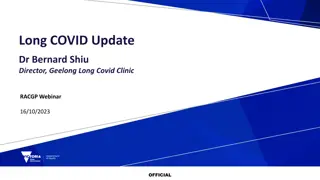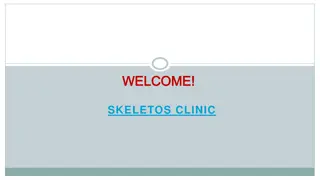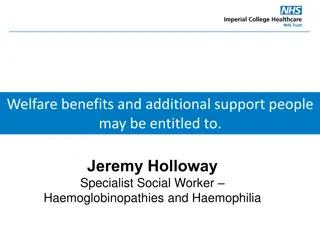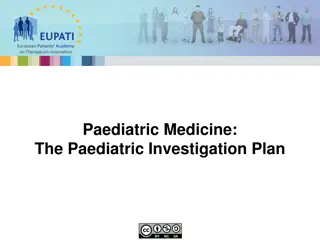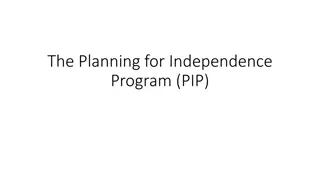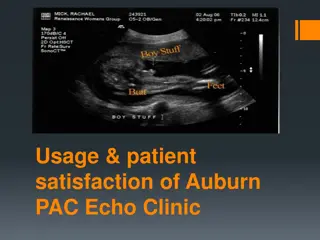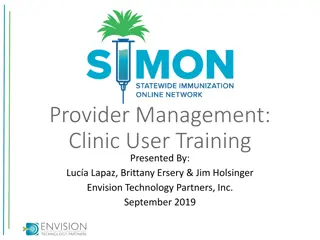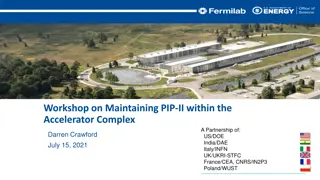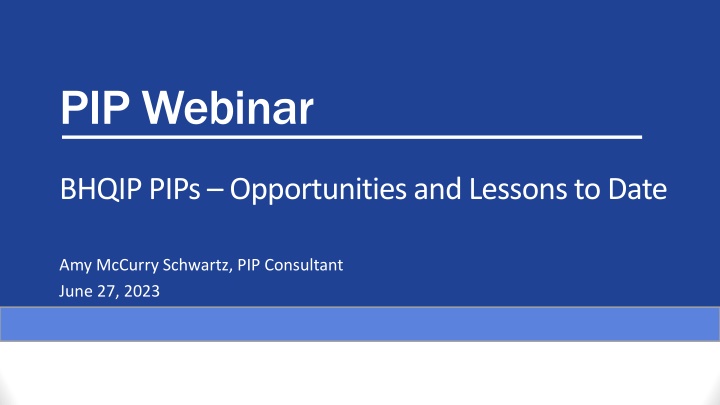
BHQIP PIPs: Opportunities and Lessons Shared
Learn about the overlap between DHCS Behavioral Health Quality Improvement Program (BHQIP) and CMS Performance Improvement Project requirements, discover key areas of opportunity in BHQIP PIP design, and understand the focus areas for counties progressing through the process. Participation insights included.
Download Presentation

Please find below an Image/Link to download the presentation.
The content on the website is provided AS IS for your information and personal use only. It may not be sold, licensed, or shared on other websites without obtaining consent from the author. If you encounter any issues during the download, it is possible that the publisher has removed the file from their server.
You are allowed to download the files provided on this website for personal or commercial use, subject to the condition that they are used lawfully. All files are the property of their respective owners.
The content on the website is provided AS IS for your information and personal use only. It may not be sold, licensed, or shared on other websites without obtaining consent from the author.
E N D
Presentation Transcript
PIP Webinar BHQIP PIPs Opportunities and Lessons to Date Amy McCurry Schwartz, PIP Consultant June 27, 2023
Purpose of Todays Webinar Discuss the overlap/relationship between the DHCS Behavioral Health Quality Improvement Program (BHQIP) Milestone 3d and the CMS PIP requirements Provide examples of areas of opportunity in the design of BHQIP PIPs Highlight some areas of focus for Counties as they progress through the BHQIP PIP Process
Introduction CalEQRO partnered with DHCS to align BHQIP Milestone 3d deliverables with federal Performance Improvement Project (PIP) requirements to support Behavioral Health Plan (BHP) efforts This alignment is available to all counties BHQIP Data Exchange deliverable requires baseline measurement and an implemented QI Plan to improve performance on three specified HEDIS measures
What is a PIP? CMS: A PIP is a project conducted by the BHP that is designed to achieve significant improvement, sustained over time, in health outcomes and enrollee satisfaction. A PIP may be designed to change behavior at a member, provider, and/or BHP/system level. Source: CMS External Quality Review (EQR) Protocols, October 2019, Protocol 1. Validation of Performance Improvement Projects, p. 27. DHCS requires that two active PIPs are in place during the preceding 12 months of a review.
What is Milestone 3d? Milestone 3d deliverables require baseline measurement and an implemented QI Plan to improve performance on the following three HEDIS measures: Follow-up After Emergency Department Visit for Alcohol and Drug Abuse or Dependence (FUA) Follow-up After Emergency Department Visit for Mental Illness (FUM) Pharmacotherapy for Opioid Use Disorder (POD)
Participation in the BHQIP PIP is OPTIONAL Counties need to meet the requirements in the DHCS reporting templates to receive BHQIP incentive payments. Counties may submit the BHQIP Milestone 3d template(s) to CalEQRO for consideration as a PIP. Counties who submit the completed DHCS templates to DHCS but choose not to participate in the BHQIP PIP will still be responsible for two MHP PIPs (all counties) and two DMC-ODS PIPs (for DMC-ODS counties).
How MHPs Participate in the BHQIP PIP To be considered for a PIP, the BHP must submit the following, at the time of EQR document submission: For MHP PIP Credit: Completed Milestone 3d Template B (in lieu of the PIP Development tool) Evidence of PIP activity since last EQR, including activity since the Template was submitted to DHCS CalEQRO will review and validate the BHQIP PIP during the scheduled annual review process. CalEQRO may request additional information during the validation process.
How DMC-ODS Participate in the BHQIP PIP To be considered for a PIP, the BHP must submit the following, at the time of EQR document submission: For DMC-ODS PIP Credit: Completed Milestone 3d Template A and/or Template C (in lieu of the PIP Development tool) Evidence of PIP activity since last EQRO, including activity since the Template was submitted to DHCS CalEQRO will review and validate the BHQIP PIP during the scheduled annual review process. CalEQRO may request additional information during the validation process.
Validation of all DHCS submissions For CMS PIP credit the DHCS Milestone 3d Template A, B, C will be validated with the CalEQRO PIP Validation Tool All PIPs submitted for BHQIP credit will be validated according to CMS Protocol 1: Validating a Performance Improvement Project BHPs will be expected to submit any additional information as requested by CalEQRO to facilitate the competition of the Validation Tool
TEMPLATES A, B, C SECTIONS 1-5: COUNTY RESPONSIBILITY Q3: Problem Statement: what is the problem this performance improvement plan proposes to solve? Q4: Who was involved in identifying the problem? Q6: What are the potential root causes for this problem? Q7: What specific data support the above root cause analysis? Q9: What is the aim/goal for this performance improvement project? Q5: Describe the beneficiary or enrollee population affected by the problem. n/a Q13: Provide performance metrics, including both outcome and process measures, relevant to the project. Describe how each intervention connects to these performance metrics. Q14: Please identify one or more disparities in this measure (by race, ethnicity, language, geography, age, etc.) that needs to be addressed by this performance improvement project. Provide supporting data for this disparity. Q16: How are beneficiaries or the stakeholders who are affected by/concerned with the issue included in the quality improvement process?
TEMPLATES A, B, C VALIDATION TOOL SECTIONS 6-9: COUNTY RESPONSIBILITY SECTIONS 6-9: EQRO RESPONSIBILITY Section 6: Assess the Improvement Strategies (CMS Identifies this as Activity 1, Step 8) Q10: Briefly state the preliminary intervention(s) selected to address the root causes. Q11: Why were these interventions chosen (i.e., what evidence suggested that these interventions would address the identified causes)? Q12: Describe when and how often the interventions will be applied. Q15: How does the improvement strategy specifically help address the health disparities identified in this measure as well as the cultural and linguistic needs for the relevant beneficiaries? Q17: Identify steps your county behavioral health plan will take in the next year to begin building capacity to collect and exchange relevant data for this measure and this performance improvement project. Section 7: Review the Data Collection Procedures (CMS Identifies this as Activity 1, Step 6) Q18: How will improved data exchange capabilities be leveraged in achieving this aim statement? Q19: Describe the planned systematic method for collecting and exchanging valid and reliable data. Q20: Describe the planned frequency for collecting and exchanging data. Q21: How will each of the interventions outlined in Question 10 be assessed for effectiveness and re-strategizing? How often will these assessments occur (must be at least quarterly)? Section 8: Review Data Analysis and Interpretation of PIP Results (CMS Identifies this as Activity 1, Step 7) Not addressed at this time. Section 9: Assess the Likelihood that Significant and Sustained Improvement Occurred
Relationship between EQR PIPs and BHQIP PIPs VALIDATION TOOL TEMPLATES A, B, C SECTIONS 10-11: EQRO RESPONSIBILITY Section 10: Perform Overall Validation and Reporting of PIP Results SECTIONS 10-11: COUNTY RESPONSIBILITY No county responsibility No county responsibility Section 11: Perform Overall Validation and Reporting of PIP Results
Timeline Implementation Remeasurement Analysis Closing Implementation Remeasurement Analysis Baseline Measurement & Planning
December PIP Clinic Topics Establishing a Problem Using Data Developing a Plan Root Cause Analysis Establishing Interventions Based on Root Cause Analysis
March PIP Clinic Topics Implementing interventions for BHQIP PIP based on Root Cause Analysis Developing Data Collection and Implementation plans Measuring the effectiveness of Interventions # of patients referred from ED to BHP # of referred patients who complete follow up appointment
June PIP Clinic Topics Intervention Review Collaboration and Barrier analysis involving the ED (FUM/FUA) Capacity to respond to referrals (FUM) Single point of contact for EDs (FUM) Further analysis for pinpoint intervention identification (FUM) Ensuring linkage to Data Exchange
BHQIP PIPs = BHQIP Goal 3, Milestone 3d BHQIP Goal 1: Payment Reform 3 Milestones BHQIP Goal 2: Implementation of CalAIM BH Policy Changes 5 Milestones BHQIP Goal 3: Data Exchange 4 Milestones Milestone 3d: Leverage improved data exchange capabilities to improve quality and coordination of care.
FUA Follow-up After Emergency Department Visit for Alcohol and Drug Abuse or Dependence (FUA) The percentage of emergency department (ED) visits for members 13 years of age and older with a principal diagnosis of alcohol or other drug (AOD) dependence, who had a follow up visit for AOD within 7 days and 30 days of being seen in the ED.
FUA Interventions Intervention for DMC_ODS(1): Brochure on AUD for members who present in the ED that is culturally appropriate. Interventions for DMC_ODS(2): Receive an ADT (Admit, Discharge, Transfer) data feed from the MCPs in addition to the claims data the Plan is currently receiving. Create and push alerts to SUD providers for open clients who have ED visits for SUD Work with the system of care directors and other stakeholders to create and roll out an alert system for SUD providers to coordinate ongoing follow-up services.
FUA Interventions Intervention for DMC_ODS(3): Implement a collaborative care model Screening in the ED Referral tracking mechanism to support real-time ED to DMC_ODS referral coordination Care coordination after discharge from the ED Collaborate to train staff participants in the ED and among screeners and assessors at DMC-ODS Access and provider sites.
FUA Interventions Interventions for DMC_ODS (4): Communication process with the ED where DMC_ODS is alerted about its clients within one day of ED discharge Access Crisis Team utilizes the EHR to track referrals from EDs, review the discharge packets, and enter the data into Avatar. Access Crisis Team refers beneficiaries to either the client s existing treatment team or to a post-hospital team for assessment and referral to an appropriate care team.
FUA Interventions Interventions for DMC_ODS (5): Collaborate with local hospital EDs to design and implement formal systems for the screening of SUD clients with ED visits for SUDs or related to SUDs, the EDS will refer to DMC_ODS for follow-up SUD treatment. Real-time tracking mechanisms will ensure an effective referral process. # and % of members identified and referred to in-hospital screeners # and % of those identified with SUDs and referred who are then screened # and % of those screened who were then referred to DMC-ODS for assessment and treatment # and % referred to DMC_ODS who were then assessed within 7 and 30 days # and % assessed who were then admitted to treatment within 7 and 30 days.
FUM Follow-up After Emergency Department Visit for Mental Illness (FUM) The percentage of emergency department (ED) visits for members 6 years of age and older with a principal diagnosis of mental illness, who had a follow-up visit for mental illness who had a follow up visit for AOD within 7 days and 30 days of being seen in the ED.
FUM Interventions Intervention for MHP (1): Implement a collaborative care model with the ED, information sharing through a data feed, and procedures to link beneficiaries to the MHP from the ED. The MHP is partnering with the MCP in this PIP. Intervention for MHP (2): Assertive Outreach Safety planning Peer support services Care coordination Check-ups
FUM Interventions Intervention for MHP (3): Develop a communication process and referral process from the ED, tracking ED referrals and collecting the data in Avatar, and forming a dedicated care team. The MHP began the intervention in February meeting with and posting informational fliers with ED staff promoting referrals. The MHP reports receiving a high volume of referrals that exceed staffing capacity. Number of successful data exchanges with MCP Number of successful data exchanges with HIE Percentage of beneficiaries with a MH condition receiving follow up services within 7 days post ED discharge (FUM7) Percentage of beneficiaries with a MH condition receiving follow up services within 30 days post ED discharge (FUM30)
FUM Interventions Interventions for MHP (4): Establish a Behavioral Health Care Navigator point of contact for EDs, available 24/7, who will perform the following functions upon contact from an ED. Look up patients in the SMHS EHR to determine if and where client is already open to SMHS services. Schedule a follow-up appointment with an SMHS existing provider -or- schedule an intake appointment for new patients in need of outpatient mental health follow-up.
FUM Interventions Interventions for MHP (5): Implement information sharing through a data feed Procedures to link beneficiaries from the ED and care coordination Partnership with two local hospital EDs These interventions should have corresponding Performance Measures the MHP only had the FUM7 and FUM30 as PMs.
FUM Interventions Intervention for MHP (6): The MHP has staff co-located within the ED. Their current ability to provide care coordination and follow-up services after discharge is built into the MHP system of care. The addition of collaboration between the MHP and MCP will enhance the current gap of communication for those currently not linked between the ED and MHP. - Number of referrals from the ED to BH through the referral tracking system and % complete - Number and percent of clients receiving follow-up services within 7 and 30 days of discharge from ED
FUM Performance Measures # of ED patient info requests to Care Navigator during business hours # of ED patient info requests made to Care Navigator during after-hours (inclusive of nights, weekends, and holidays) # of patients Open to SMHS at time of ED request # of patients Not Open to SMHS at time of ED request Total # of follow-up appts made by Care Navigator # of follow-up appts made by Care Navigator for ER patients Open to SMHS # of follow-up appts made by Care Navigator for ER patients Not Open to SMHS # of follow-up appts scheduled by Care Navigator that were attended by patient
POD Pharmacotherapy for Opioid Use Disorder (POD) The percentage of opioid use disorder (OUD) pharmacotherapy treatment events among members age 16 and older that continue for at least 180 days (6 months).
POD Interventions Interventions for DMC_ODS (7): Drop-in to mindfulness recovery groups weekly at the County Medication sites for SUD and experience positive support and learn new skills to support retention in treatment Enhance engagement and coping skill activities at the sites to help clients remain on methadone or other OUD drugs and expand opportunities for support
POD Interventions Interventions DMC_ODS (8): Beneficiaries can opt into follow-up care coordination and support to continue their MOUD treatment. The Care Coordination Team will make follow-up contact with beneficiaries who initiate MOUD treatment and will follow updated result-oriented Care Coordination Guidelines that include evidence-based practices to ensure continuity of outreach, and continuity of tracking and monitoring of beneficiary engagement and beneficiary needs. o Outreach includes phone calls, utilization of telehealth and field services. Establish HIE transmissions within HIE o To identify beneficiaries who initiate MOUD and are discharged from the ED with a workflow to track new and returning ED patients and referrals. Dedicated entity/person to gather and track beneficiary data and information that includes but is not limited to status of treatment placement and other referrals
POD Performance Measures # of successful HIE transmissions within the Dignity Health HIE # of admissions, discharge, and transfer (ADT) Feed transmission to the Plan # of successful alerts transmitted to care coordinators indicating a MOUD visit, including beneficiaries who have not previously received care from the Plan # of referrals for follow-up on MOUD s received through the interim manual staff to staff referral process. # and % of clients screened for social determinants of health needs that impact engagement in treatment, who received a service or referral to address those needs. # and % of clients screened for MH, medical, and other substance use needs who received a referral to address those needs. # of beneficiaries for whom a referral is made, who receive follow up for MOUD. % of beneficiaries who have initiated new OUD pharmacology events with medication for OUD (MOUD), without a gap of 8 or more consecutive days.
Timeline Implementation Remeasurement Analysis Closing Implementation Remeasurement Analysis Baseline Measurement & Planning
Contact Information Amy McCurry Schwartz, Esq., MHSA amy.mccurry@bhceqro.com (855) 385-3776 x 103 *PIP Technical Assistance is available from your assigned Quality Reviewer www.caleqro.com




